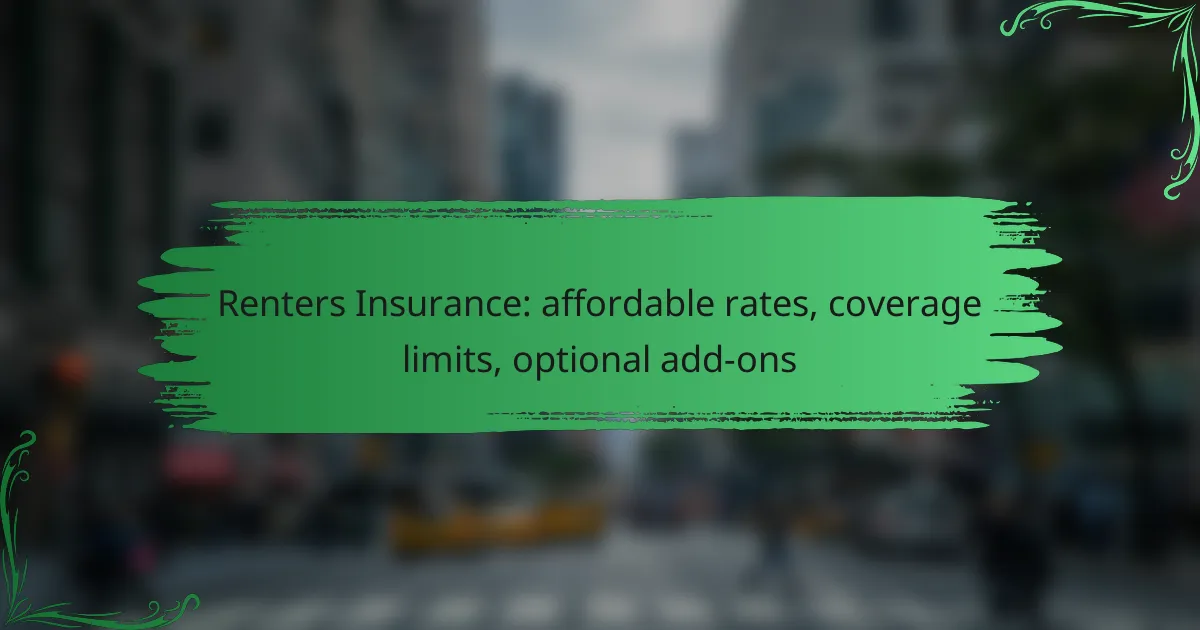Renters insurance is essential for protecting your personal belongings and liability, and finding affordable rates requires careful comparison of policies. Coverage limits can vary significantly, with personal property protection often ranging from tens of thousands to over a hundred thousand dollars. Additionally, optional add-ons can enhance your policy by covering specific risks, ensuring you have comprehensive protection tailored to your needs.

How to find affordable renters insurance in the UK
Finding affordable renters insurance in the UK involves comparing various policies to ensure you get the best coverage at a reasonable price. Start by evaluating your needs and then explore different providers to identify options that fit your budget and requirements.
Compare quotes from multiple providers
To secure the best deal on renters insurance, it’s essential to compare quotes from several insurance companies. Each provider may offer different coverage limits and premiums, so obtaining at least three to five quotes can help you identify the most cost-effective option.
Use online comparison tools or visit individual insurer websites to gather quotes. Pay attention to the specifics of what each policy covers, as the cheapest option may not always provide adequate protection for your belongings.
Consider bundling with other insurance
Bundling renters insurance with other types of insurance, such as car or life insurance, can lead to significant savings. Many insurers offer discounts for customers who combine multiple policies, which can reduce your overall insurance costs.
When considering bundling, ensure that the coverage limits and terms of each policy meet your needs. Evaluate the total cost of bundled policies against purchasing them separately to determine the best financial choice.
Look for discounts and promotions
Many insurance providers offer discounts that can make renters insurance more affordable. Common discounts include those for having security features in your home, being a member of certain organizations, or maintaining a claims-free history.
Stay informed about seasonal promotions or special offers that insurers may provide. Checking directly with your provider or using online resources can help you uncover potential savings that apply to your situation.

What are the typical coverage limits for renters insurance?
Renters insurance typically offers coverage limits that vary based on the policy and provider. Most policies provide personal property coverage ranging from tens of thousands to over a hundred thousand dollars, while liability coverage often starts around $100,000.
Personal property coverage limits
Personal property coverage limits in renters insurance protect your belongings from risks like theft, fire, or vandalism. Standard limits usually range from $20,000 to $100,000, depending on the policy. It’s crucial to assess the value of your possessions to select an appropriate coverage amount.
Many policies allow you to customize your personal property limits. For example, if you own high-value items like electronics or jewelry, consider adding scheduled personal property coverage to ensure they are fully protected.
Liability coverage limits
Liability coverage limits protect you against legal claims for injuries or damages that occur in your rented space. Typical liability limits start at $100,000, but many renters opt for higher limits, such as $300,000 or $500,000, to ensure adequate protection.
When choosing liability coverage, consider factors like the number of guests you host or the potential risks associated with your living situation. Increasing your liability limit can provide peace of mind and financial security in case of unexpected incidents.

What optional add-ons are available for renters insurance?
Optional add-ons for renters insurance enhance your coverage by protecting against specific risks not included in standard policies. Common add-ons include accidental damage coverage, personal belongings coverage outside the home, and replacement cost coverage.
Accidental damage coverage
Accidental damage coverage protects your personal property from unintentional harm, such as spills or breakage. This add-on can be particularly valuable for renters with children or pets, as accidents are more likely to occur in these households.
When considering this coverage, review the specific incidents it includes, as some policies may have exclusions. Generally, premiums for this add-on are modest, often adding a small percentage to your overall policy cost.
Personal belongings coverage outside the home
This coverage extends protection for your personal items when they are outside your rental unit, such as in your car or while traveling. It is essential for renters who frequently carry valuable items like laptops or cameras.
Check the limits of this coverage, as they can vary significantly between policies. Many insurers offer a cap on the amount you can claim for items lost or damaged outside your home, so ensure it aligns with your needs.
Replacement cost coverage
Replacement cost coverage allows you to replace lost or damaged items at their current market value, rather than their depreciated value. This means you can receive a payout that reflects what it would cost to buy new items, which is often more beneficial than standard coverage.
While this add-on typically increases your premium, it can be worth the investment, especially for renters with high-value possessions. Evaluate your belongings and consider whether the extra cost aligns with the potential benefits of having replacement cost coverage.

What factors affect renters insurance rates in the UK?
Renters insurance rates in the UK are influenced by several key factors, including your location, crime rates in the area, and your personal credit and claims history. Understanding these elements can help you find more affordable coverage and better protect your belongings.
Location and crime rates
Your location plays a significant role in determining renters insurance rates. Areas with higher crime rates typically see increased premiums due to the higher risk of theft or vandalism. For example, urban centers may have higher rates compared to rural areas.
When shopping for renters insurance, consider the crime statistics of your neighborhood. Insurers often evaluate local crime data to assess risk, so living in a safer area can lead to lower premiums. You can check local crime reports or consult with your insurance provider for insights.
Credit history and claims history
Your credit history and previous claims can significantly impact your renters insurance rates. Insurers often use credit scores to gauge risk; a higher score may result in lower premiums, while a poor credit history could lead to increased costs.
Additionally, if you have a history of frequent claims, insurers may view you as a higher risk, which can also drive up your rates. To keep costs manageable, aim to maintain a good credit score and limit the number of claims you file, opting for out-of-pocket payments for minor damages when possible.

How to choose the right renters insurance policy?
Choosing the right renters insurance policy involves assessing your personal property value and evaluating your liability needs. This ensures you have adequate coverage without overpaying for unnecessary extras.
Assess your personal property value
To determine the right renters insurance policy, start by calculating the total value of your personal belongings. This includes furniture, electronics, clothing, and other items. A common approach is to create an inventory list and assign approximate values to each item.
Consider using a renters insurance calculator, which can help estimate coverage limits based on your inventory. Typically, coverage amounts can range from a few thousand to tens of thousands of dollars, depending on your needs. Ensure your policy covers the full replacement cost of your items, not just their current market value.
Evaluate your liability needs
Liability coverage protects you against claims for damages or injuries that occur in your rented space. Most renters insurance policies offer liability coverage ranging from $100,000 to $500,000. Assess your lifestyle and potential risks to determine the appropriate level of coverage.
For example, if you frequently host guests or have pets, consider opting for higher liability limits. Additionally, check if your policy includes coverage for legal fees, as these can add up quickly in case of a lawsuit. Avoid common pitfalls by not underestimating your liability exposure; it’s often worth investing in additional coverage for peace of mind.

What are the common exclusions in renters insurance?
Common exclusions in renters insurance typically include damages from natural disasters, negligence, and intentional harm. Understanding these exclusions is crucial for renters to ensure adequate protection and avoid unexpected losses.
Natural disasters
Many renters insurance policies do not cover damages caused by natural disasters such as floods, earthquakes, and hurricanes. Renters in areas prone to these events should consider additional coverage options, like flood insurance or earthquake endorsements, to protect their belongings.
For example, if you live in a flood-prone area, standard renters insurance may not help you recover losses from water damage. Research local risks and consult your insurance provider to understand what additional coverage you may need.
Negligence and intentional damage
Renters insurance typically excludes damages resulting from negligence or intentional acts. If a tenant accidentally causes a fire due to careless behavior, the insurance may not cover the resulting damages. It’s essential to maintain a safe living environment to avoid such pitfalls.
Additionally, any intentional damage caused by the tenant or their guests is usually not covered. This means that if someone deliberately vandalizes property, the insurance will likely deny the claim. Always review your policy to understand these exclusions and take proactive measures to mitigate risks.

How to file a renters insurance claim?
Filing a renters insurance claim involves notifying your insurance provider about your losses and providing necessary documentation. This process ensures that you receive compensation for covered damages or losses according to your policy.
Contact your insurance provider
The first step in filing a renters insurance claim is to contact your insurance provider as soon as possible after the incident. Most insurers have a dedicated claims hotline or online portal for reporting claims. Have your policy number ready to expedite the process.
When you reach out, provide a clear and concise description of the incident, including when and where it occurred. This initial communication sets the stage for your claim and helps the insurer understand the situation quickly.
Document your losses
Thorough documentation of your losses is crucial for a successful claim. Start by taking photographs of any damaged or stolen property, and make a detailed list of items affected, including their estimated value. This evidence supports your claim and helps the insurer assess the situation accurately.
Additionally, gather any receipts, warranties, or appraisals related to the lost items. If applicable, consider obtaining police reports for theft or vandalism incidents. Having comprehensive documentation can significantly speed up the claims process and increase the likelihood of receiving fair compensation.

What are the benefits of renters insurance?
Renters insurance provides financial protection for personal belongings and liability coverage for renters. It is an affordable way to safeguard against unexpected events such as theft, fire, or water damage.
Affordable rates
Renters insurance typically offers low monthly premiums, often ranging from $15 to $30, depending on coverage limits and location. This cost-effective option makes it accessible for many renters looking to protect their assets.
When comparing rates, consider factors like the value of your belongings, the deductible amount, and any discounts available, such as bundling with auto insurance. Shopping around can help you find the best deal tailored to your needs.
Coverage limits
Coverage limits in renters insurance define the maximum amount the insurer will pay for your personal property in case of a covered loss. Policies usually offer limits between $10,000 and $100,000, with options to increase coverage based on individual needs.
It’s essential to assess the value of your possessions accurately. Create an inventory of your items and consider their replacement costs to choose an appropriate coverage limit that adequately protects your belongings.
Optional add-ons
Many renters insurance policies offer optional add-ons to enhance coverage. Common add-ons include coverage for high-value items like jewelry or electronics, as well as identity theft protection and additional liability coverage.
Before selecting add-ons, evaluate your specific needs and the value of your possessions. This can help you determine which optional coverages are worth the additional cost and provide the best protection for your situation.



